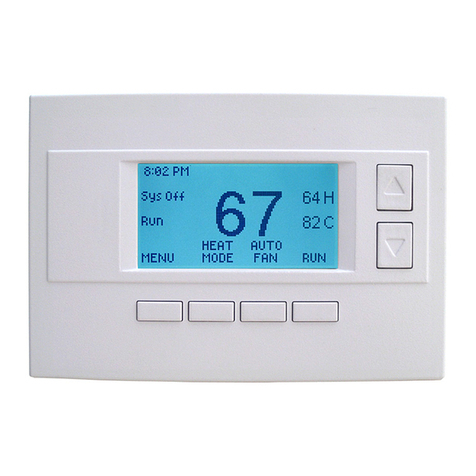
DCN: 140-01773-03 Page 7
Options: 1 to 8 degrees Default: 1
Heating Delta Stage 1 OFF Sets the delta from setpoint that stage 1 heating stops.
Stage 1 turns off at setpoint + Delta Stage 1.
Options: 0 to 8 degrees Default: 0
Heating Delta Stage 2 ON Sets the delta from setpoint that stage 2 heating starts.
Options: 1 to 8 degrees Default: 2
Heating Delta Stage 2 OFF Sets the delta from setpoint that stage 2 heating stops.
Stage 2 turns off at setpoint + Delta Stage 2.
Options: 0 to 8 degrees Default: 0
Heating Delta Stage 3 ON Sets the delta from setpoint that stage 3 heating starts.
Option: 1 to 8 degrees Default: 3
Heating Delta Stage 3 OFF Sets the delta from setpoint that stage 3 heating stops.
Stage 3 turns off at setpoint + Delta Stage 3.
Option: 0 to 8 degrees Default: 0
Cooling Delta Stage 1 ON Sets the delta from setpoint that stage 1 cooling starts.
Options: 1 to 8 degrees Default: 1
Cooling Delta Stage 1 OFF Sets the delta from setpoint that stage 1 Cooling stops.
Stage 1 turns off at setpoint - Delta Stage 1
Options: 0 to 8 degrees Default: 0
Cooling Delta Stage 2 ON Sets the delta from setpoint that stage 2 cooling starts.
Options: 1 to 8 degrees Default: 2
Cooling Delta Stage 2 OFF Sets the delta from setpoint that stage 2 Cooling stops.
Stage 2 turns off at setpoint -Delta Stage 2.
Options: 0 to 8 degrees Default: 0
Max Heat SP Sets the maximum heating setpoint value.
Will not ramp or accept setpoints higher that this maximum.
Options: 40F to 109F (4C-43C) Default: 90F (32C)
Min Cool SP Sets the minimum cooling setpoint value.
Will not ramp or accept setpoints lower than this minimum.
Options: 44F to 113F (6C-45C) Default: 60F (15C)
Min Run Time (MRT) Sets the minimum run time before a heating/cooling cycle turns off.
Sets heating/cooling cycle time. Prevents rapid cycling.
Options: 1- 9 Minutes Default: 3
Min Off Time (MOT) Sets the minimum off time before another heating/cooling cycle can
begin. Provides compressor short cycle protection.
Options: 5-9 Minutes Default: 5
Fan Cycler
The fan cycler function cycles the HVAC system fan for an ON period followed by an Off
period continuously. Used to provide minimum air ventilation requirements. When the Fan
ON time is set to a value greater than 0, an additional “Cycler” FAN mode is present when
pressing the FAN button.
Fan ON Time Options: 0-120 minutes Default: 0 (=OFF)
Fan OFF Time Options: 10-120 minutes Default: 10





























